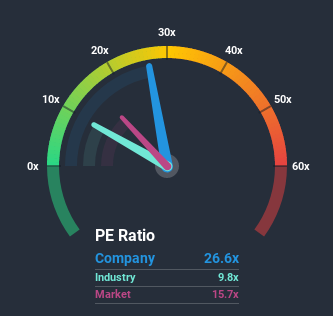Subdued Growth No Barrier To Tamawood Limited's (ASX:TWD) Price

When close to half the companies in Australia have price-to-earnings ratios (or "P/E's") below 15x, you may consider Tamawood Limited (ASX:TWD) as a stock to avoid entirely with its 26.6x P/E ratio. However, the P/E might be quite high for a reason and it requires further investigation to determine if it's justified.
For example, consider that Tamawood's financial performance has been poor lately as it's earnings have been in decline. It might be that many expect the company to still outplay most other companies over the coming period, which has kept the P/E from collapsing. If not, then existing shareholders may be quite nervous about the viability of the share price.
See our latest analysis for Tamawood
Although there are no analyst estimates available for Tamawood, take a look at this free data-rich visualisation to see how the company stacks up on earnings, revenue and cash flow.
Is There Enough Growth For Tamawood?
Tamawood's P/E ratio would be typical for a company that's expected to deliver very strong growth, and importantly, perform much better than the market.
If we review the last year of earnings, dishearteningly the company's profits fell to the tune of 66%. This means it has also seen a slide in earnings over the longer-term as EPS is down 72% in total over the last three years. So unfortunately, we have to acknowledge that the company has not done a great job of growing earnings over that time.
Comparing that to the market, which is predicted to shrink 0.2% in the next 12 months, the company's downward momentum is still inferior based on recent medium-term annualised earnings results.
In light of this, it's odd that Tamawood's P/E sits above the majority of other companies. With earnings going quickly in reverse, it's not guaranteed that the P/E has found a floor yet. There's potential for the P/E to fall to lower levels if the company doesn't improve its profitability, which would be difficult to do with the current market outlook.
The Bottom Line On Tamawood's P/E
The price-to-earnings ratio's power isn't primarily as a valuation instrument but rather to gauge current investor sentiment and future expectations.
Our examination of Tamawood revealed its sharp three-year contraction in earnings isn't impacting its high P/E anywhere near as much as we would have predicted, given the market is set to shrink less severely. Right now we are increasingly uncomfortable with the high P/E as this earnings performance is unlikely to support such positive sentiment for long. We're also cautious about the company's ability to stay its recent medium-term course and resist even greater pain to its business from the broader market turmoil. Unless the company's relative performance improves markedly, it's very challenging to accept these prices as being reasonable.
Don't forget that there may be other risks. For instance, we've identified 4 warning signs for Tamawood (1 is significant) you should be aware of.
If these risks are making you reconsider your opinion on Tamawood, explore our interactive list of high quality stocks to get an idea of what else is out there.
This article by Simply Wall St is general in nature. It does not constitute a recommendation to buy or sell any stock, and does not take account of your objectives, or your financial situation. We aim to bring you long-term focused analysis driven by fundamental data. Note that our analysis may not factor in the latest price-sensitive company announcements or qualitative material. Simply Wall St has no position in any stocks mentioned.
Have feedback on this article? Concerned about the content? Get in touch with us directly. Alternatively, email editorial-team@simplywallst.com.

 Yahoo Finance
Yahoo Finance 
